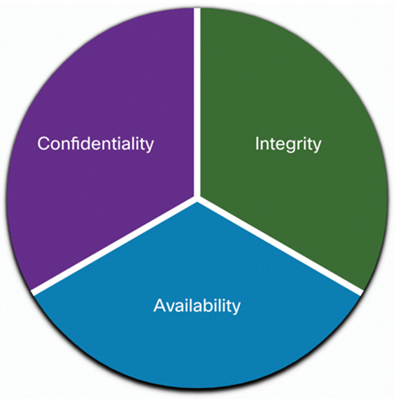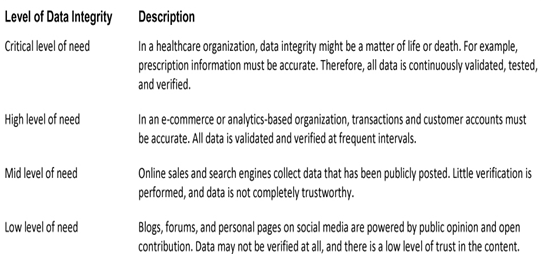Confidentiality, Integrity, and Availability (39.1.2)
It is true that the list of network attack types is long. But there are many best practices that you can use to defend your network, as you will learn in this chapter.
Network security consists of protecting information and information systems from unauthorized access, use, disclosure, disruption, modification, or destruction.
Most organizations follow the CIA information security triad, as shown in Figure 39-4. Since it forms the foundation of cybersecurity practice, it is important that you have a detailed understanding of the three principles:
- Confidentiality—Only authorized individuals, entities, or processes can access sensitive information. It may require using cryptographic encryption algorithms such as AES to encrypt and decrypt data.
- Integrity—Refers to protecting data from unauthorized alteration. It requires the use of cryptographic hashing algorithms such as SHA.
- Availability—Authorized users must have uninterrupted access to important resources and data. It requires implementing redundant services, gateways, and links.

Figure 39-4 The CIA Triad
CIA Triad—The Principle of Confidentiality (39.1.3)
To accomplish confidentiality without using encryption, tokenization is a substitution technique that can isolate data elements from exposure to other data systems. A random value with no mathematical relationship replaces original data. Outside the system, a token has no value and is meaningless. Tokenization can preserve the data format (its type and data length), which makes it useful for databases and card payment processing.
Rights management covers both digital rights management (DRM) and information rights management (IRM). Both protect data from unauthorized access by using encryption.
DRM protects copyrighted material like music, films, or books. When any such content appears in digital form—for instance on CD, mp3, or e-book—it is encrypted, so the media cannot be copied without the decryption key. The decryption key is available only to licensed parties.
IRM is used with email and other files that are relevant to the activities and communications of an organization. When this information is shared with others, IRM allows the document owner, the organization, or one of its members to control and manage access to the document.
Activity—Protecting Data Privacy (39.1.4)
Refer to the online course to complete this activity.
Integrity is the accuracy, consistency, and trustworthiness of data across its entire life cycle.
Data undergoes several operations, such as capture, storage, retrieval, update, and transfer. Data must remain unaltered by unauthorized entities during all these operations.
Methods used to ensure data integrity include hashing, data validation checks, data consistency checks, and access controls. Data integrity systems can include one or more of these methods.
Data integrity is a fundamental component of information security. Ensuring data integrity is a constant challenge for most organizations. Loss of data integrity can render entire data resources unreliable or unusable.
However, the importance of data integrity varies based on how an organization uses its data. For example, a bank or financial organization assigns a higher importance to data integrity than a social media channel.
Table 39-1 ranks the levels of data integrity.

Table 39-1 Levels of Data Integrity
Activity—Availability (39.1.6)
Availability refers to the need to make data accessible to all authorized users whenever they need it. Cyberattacks and system failures can prevent access to information, systems, and services.
Refer to the online course to complete this activity.
